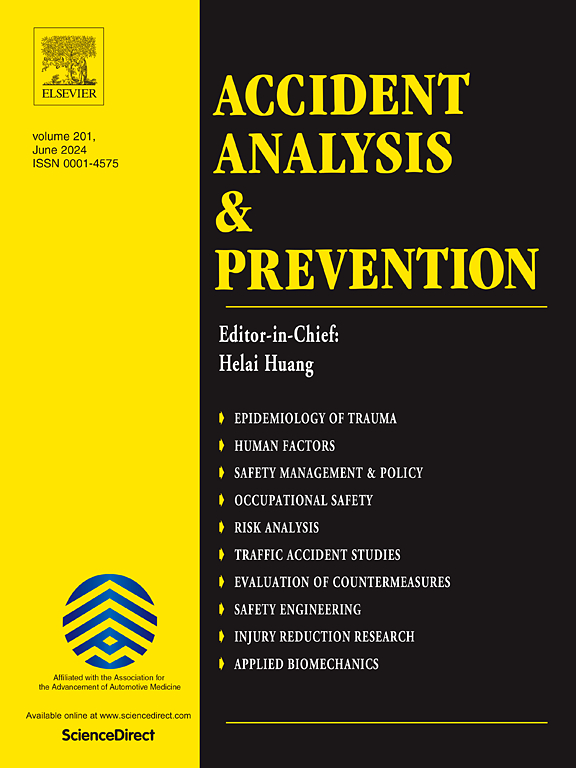Safe streets for cyclists? Quantifying the causal impact of cycling infrastructure interventions on safety
IF 6.2
1区 工程技术
Q1 ERGONOMICS
引用次数: 0
Abstract
London’s Cycle Superhighways (CS) form a network of cycle routes connecting central London to outer boroughs, introduced in 2010 to promote cycling and improve safety. This paper examines their causal impact on cycling volume and safety using detailed road traffic and road safety data from the UK’s Department for Transport. To estimate these effects, we employ propensity score-matched difference-in-differences and panel outcome regression models, comparing two distinct infrastructure types: segregated and non-segregated CS. A key contribution of this study is the development of a novel safety indicator — the normalised collision rate — that accounts for changes in cyclist volume (exposure) while incorporating expected non-linearities in the relationship between collisions and exposure. Our findings indicate that non-segregated CS did not increase cycling volume but led to a substantially higher collision rate. This increase appears to be driven by a post-intervention surge in the proportion of new, inexperienced cyclists along these routes. In contrast, segregated CS effectively increased cycling volume without increasing collision rates. Further, an evaluation of a major segregation upgrade along an existing non-segregated CS route revealed a notable reduction in collision rates. These results highlight the crucial role of segregated infrastructure in not only encouraging cycling but also ensuring it remains a safe and viable urban transport option.
为骑自行车的人提供安全的街道?量化自行车基础设施干预对安全的因果影响
伦敦的自行车高速公路(CS)形成了一个连接伦敦市中心和外围行政区的自行车路线网络,于2010年推出,旨在促进骑自行车和提高安全性。本文使用英国交通部的详细道路交通和道路安全数据,研究了它们对骑行量和安全的因果影响。为了估计这些影响,我们采用倾向得分匹配差异中的差异和面板结果回归模型,比较了两种不同的基础设施类型:隔离和非隔离的CS。这项研究的一个关键贡献是开发了一种新的安全指标——归一化碰撞率——它考虑了骑自行车者数量(暴露)的变化,同时纳入了碰撞和暴露之间的预期非线性关系。我们的研究结果表明,非隔离的CS并没有增加骑行量,但却导致了更高的碰撞率。这一增长似乎是由于干预后这些路线上新手和没有经验的骑车人比例激增。相比之下,隔离的CS在不增加碰撞率的情况下有效地增加了骑行量。此外,对现有非隔离CS路线的主要隔离升级的评估显示,碰撞率显着降低。这些结果突出了隔离基础设施的关键作用,不仅鼓励骑自行车,而且确保它仍然是一个安全可行的城市交通选择。
本文章由计算机程序翻译,如有差异,请以英文原文为准。
求助全文
约1分钟内获得全文
求助全文
来源期刊

Accident; analysis and prevention
Multiple-
CiteScore
11.90
自引率
16.90%
发文量
264
审稿时长
48 days
期刊介绍:
Accident Analysis & Prevention provides wide coverage of the general areas relating to accidental injury and damage, including the pre-injury and immediate post-injury phases. Published papers deal with medical, legal, economic, educational, behavioral, theoretical or empirical aspects of transportation accidents, as well as with accidents at other sites. Selected topics within the scope of the Journal may include: studies of human, environmental and vehicular factors influencing the occurrence, type and severity of accidents and injury; the design, implementation and evaluation of countermeasures; biomechanics of impact and human tolerance limits to injury; modelling and statistical analysis of accident data; policy, planning and decision-making in safety.
 求助内容:
求助内容: 应助结果提醒方式:
应助结果提醒方式:


